Heading out the door? Read this article on the new Outside+ app available now on iOS devices for members! Download the app.
There’s nothing like the feeling of two sets of edges connecting with fresh corduroy in arc after arc, leaving railroad tracks behind you—like an artist signing their name on a canvas. That’s the rush carving skis can offer.
With waist widths hovering in the 60- to 80-millimeter range and more dramatic sidecuts than you’ll see on all-mountain skis, carving skis (also known as piste skis) are designed to help you get on edge and play with the turn shape, tempo, and degree of your arcs. All models in this category are built to perform at their best on groomers—hard or soft—while some are tuned to carve short turns, some long, and some in the middle. Some have race pedigrees with constructions designed for precision and edge grip, while others have more playful and forgiving personalities.
The 30 testers who participated in our 2025 SKI Test at Big Sky, Montana, last March got a lot of satisfaction from seeing which carvers left the best trenches in the snow. By day’s end, it was clear that not all carving skis are created equal. Whether you’re looking for a seriously directional carver or a more accessible option that will coax you into a beautiful turn, this year’s best carving skis will not disappoint.
Section divider
At a Glance
- Best in Test: Fischer RC4 Noize ($1,400)
- Most Versatile: Nordica Dobermann Multipista DC ($1,200)
- Best for Experts: Atomic Redster X9S Revoshock S ($1,250)
- Best for Firm Snow: Head WC Rebels e-Speed ($1,338)
- Most Fun: Blizzard Thunderbird R15 76 ($1,300)
- Most Responsive: Völkl Peregrine 72 ($1,200)
- Best for Beginners: Dynastar M-Cross 78 ($550)
More Skis We Recommend
Section divider
The Reviews: The Best Carving Skis
Of the 13 unisex carving skis we tested at our annual SKI Test in Big Sky, Montana, these seven stood out as top performers. They earned the highest marks across nine scoring criteria, with especially strong results in carving, hard-snow performance, and stability at speed—the three performance characteristics we prioritize when reviewing carving skis. Read more about our testing process here.
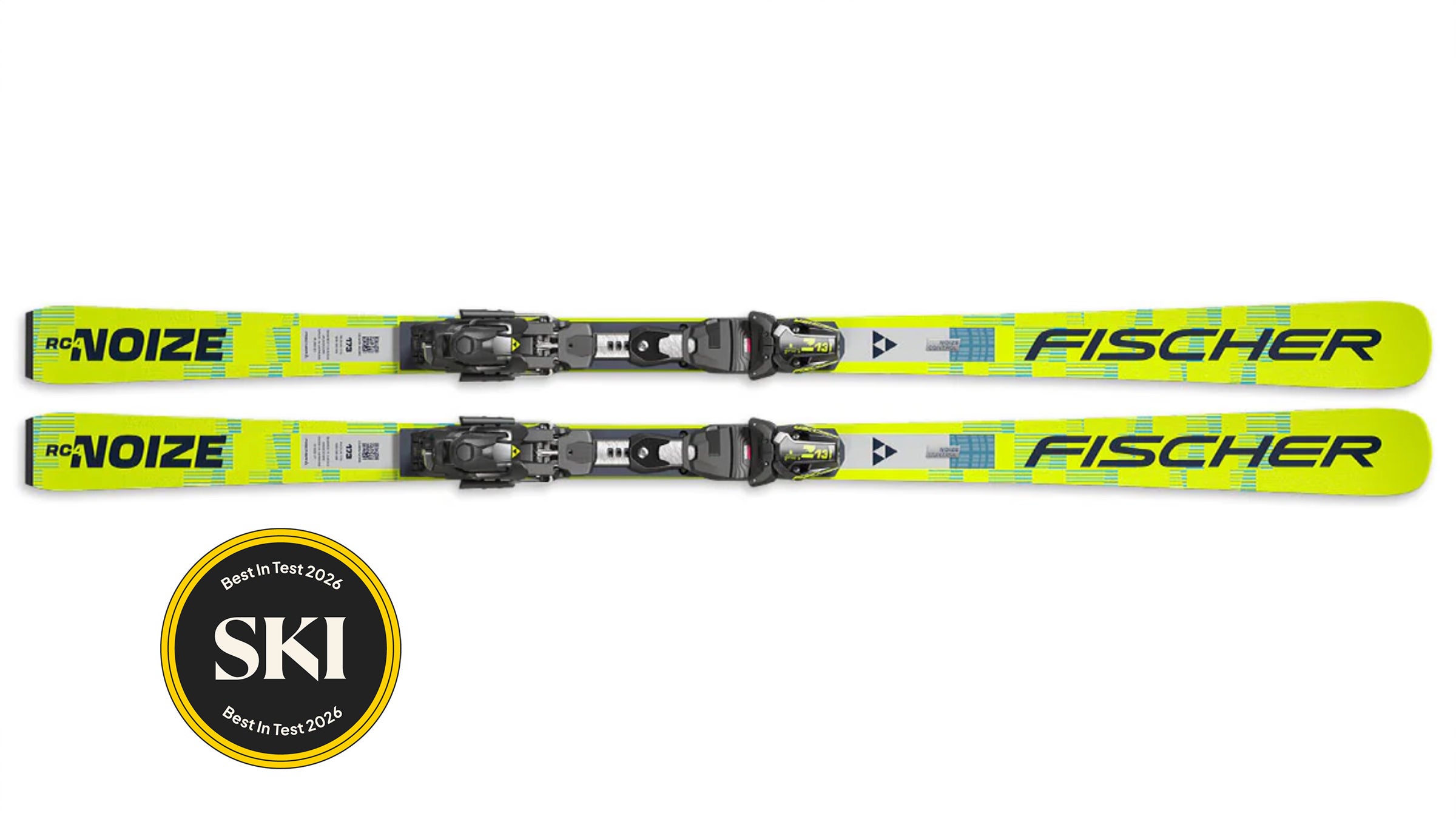
Best in Test: Fischer RC4 Noize
Lengths: 168, 173, 178, 183 cm
Dimensions: 112-66-101 mm
Pros and Cons
⊕ Precise
⊕ Balanced
⊕ Requires fundamental carving skills
⊗ Slalom turns are not its forte
The new RC4 Noize made a big impression on our test crew, who ultimately named it the best carving ski at our 2025 SKI Test. The 66-millimeter-waisted ski received the top score in our carving scoring criterion, a big feat in a crowded field of high-performance skis. It also received high marks for hard-snow integrity and stability, nailing the scoring criteria that we emphasize most when judging groomer skis. “This is a real winner,” said tester Tommy Flitton, a freeride coach based at Snowbird, Utah. “It has no speed limit and is extremely smooth.”
Engineers of Fischer’s new Noize Control technology say they took their inspiration from music. Think about an instrument like a guitar and picture how soundwaves are created by the vibration of a plucked string. That’s similar to the vibrations created as the ski travels down the slope. Now imagine 3D-printed mini metal particles under the topsheet of the ski which can absorb and control those vibrations. The result? “Vibrations are non-existent,” said Chad Jacob, a New York-based tester and race coach. “This is a very strong, balanced ski that will make both cruisers and high-speed skiers really happy. It just locks you into the turn and holds.”
That said, it’s not a ski for those who want to sit back, relax, and let the ski take control. Testers dinged the ski for a lack of forgiveness and versatility, partly because this groomer-only ski favors medium-to-long radius turns, and makes short swing turns off-piste a chore. It also requires some carving know-how. “The only knock is this ski needs a strong pilot,” said 5-foot-7 tester Matt Coté. Read the full review here.
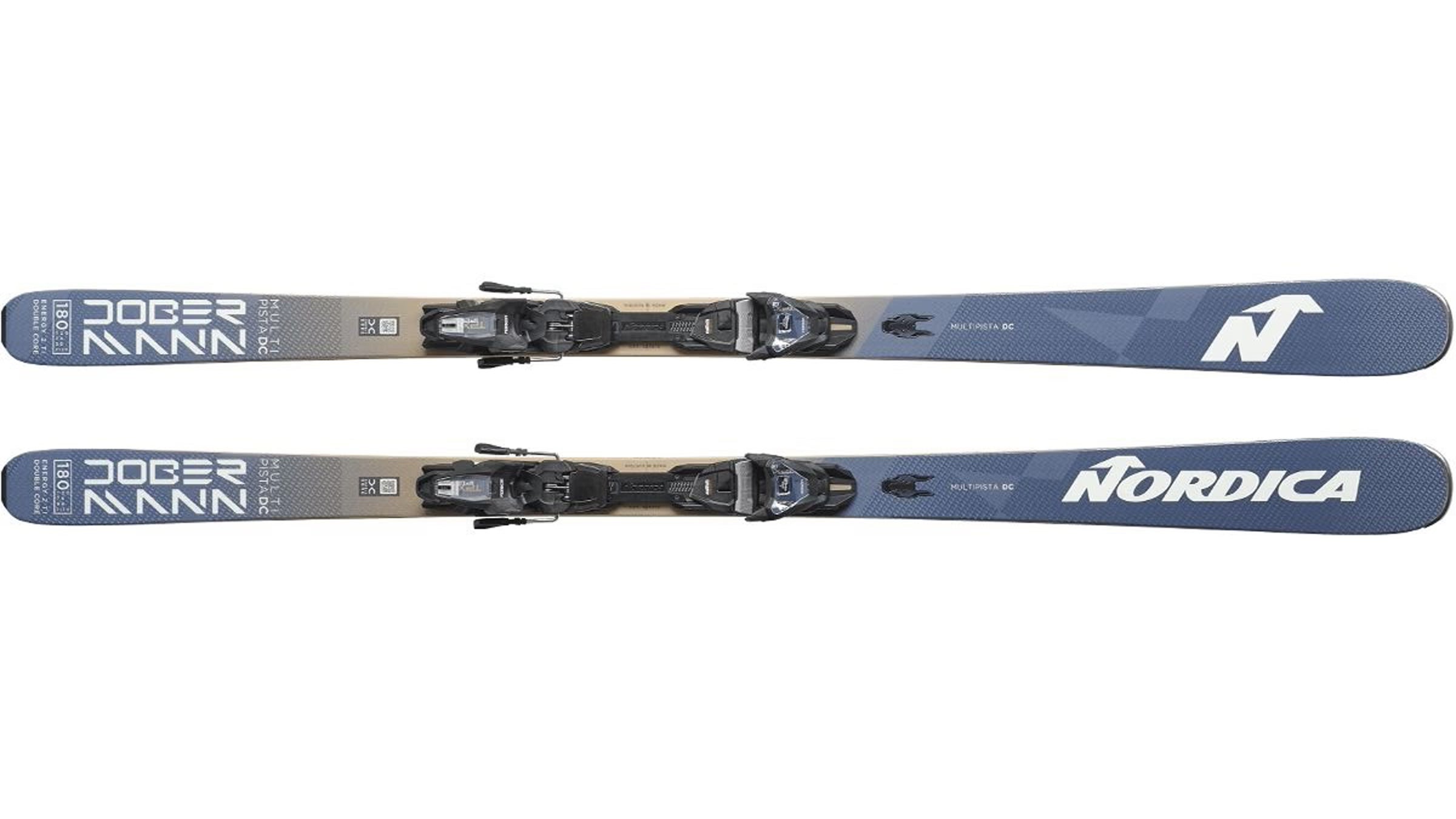
Most Versatile: Nordica Dobermann Multipista DC
Lengths: 160, 165, 170, 175, 180, 185 cm
Dimensions: 119-74 -97 mm
Pros and Cons
⊕ An intuitive carver
⊕ Jack-of-all-trades
⊗ Stiff tail
⊗ Low rebound energy
The all-new Dobermann Multipista DC is a hybrid creature that surprised us at our test in Big Sky, Montana. While it looks like an intimidating race carver, it proved more intuitive and versatile than expected. The Multipista’s rockered all-terrain tip makes for easy turn initiation, yet its stiff, straight tail means business on hardpack. This combo makes for an exceptionally fun yet solid ride. “There’s intuitive turn shape adjustment in the tip, stability and dampness while in the turn, and energy return on edge-to-edge transitions,” reported Otto Gibbons, a five-foot-six expert skier and hardgoods buyer from Washington.
The Dobermann Multipista DC received its highest scores for stability at speed and carving, but also topped the charts in playfulness and versatility—a testament to its dual nature. Construction includes two outer layers of Titanal over two wood cores with an elastomer layer in the middle. “The elastomer has some tradeoffs,” said Brady Newton, an engineer and seasoned ski tester. “It can quell vibrations, but it can also make the ski feel like it has less energy out of the turn.” While experts might lament the lack of exciting rebound, testers felt that the ski’s “no-surprise performance” might make it more appealing to strong intermediates.
What we like most about this ski: with a 74-millimeter-waists, it’s not just a carver. While it’s most at home on groomers, it has enough of a platform to venture into moguls and the glades beyond the trail markers, too.
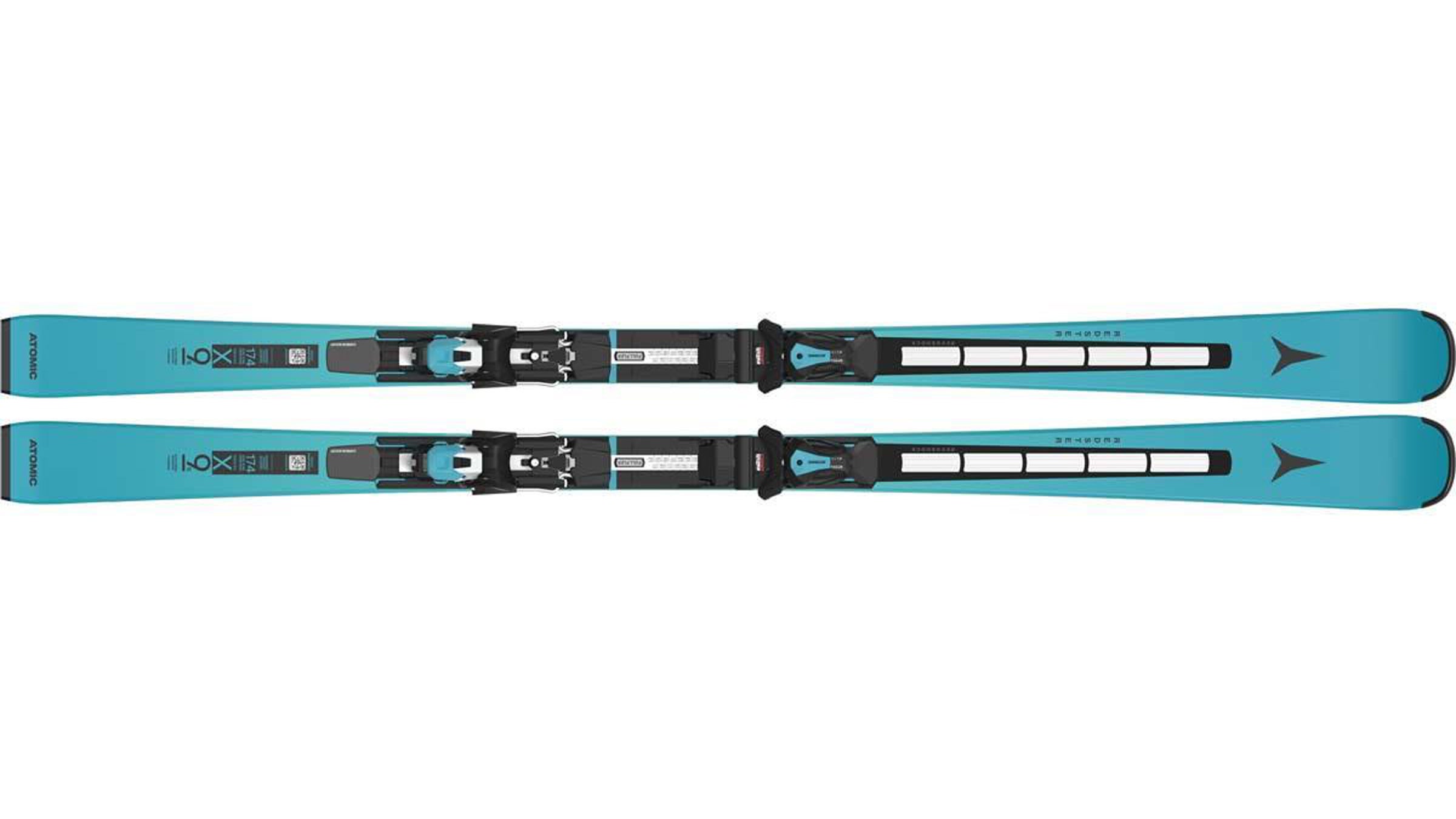
Best for Experts: Atomic Redster X9S Revoshock S
$1,050 within binding at Skis.com
Lengths: 166, 174, 182 cm
Dimensions: 114-65-99.5 mm
Pros and Cons
⊕ Exceptional rebound energy
⊕ Excellent hard-snow integrity
⊕ Unforgiving
⊗ Race-ski stiff
Unabashedly race-inspired, the 65-millimeter waisted Redster X9S received its highest scores for hard-snow integrity and stability at speed, eliciting tester comments like “groomers or bust” and “ripping beer league race ski.” “This is everything a carving ski should be,” said tester Alex Cernichiari, a five-foot-ten expert skier. “It can make any turn radius, is mostly approachable, and handles speed with aplomb.”
Construction includes Atomic’s double titanium-enhanced wood core, used in their FIS race series skis, and Revoshock technology, which absorbs and rebounds energy with what Atomic-athlete Mikaela Shiffrin describes as “the perfect combination of control, stability and acceleration.” Former ski racers on our test crew loved the ski’s acceleration out of turn. “It really loads you up and springs you into the next turn,” said Cooper Johnson, an Aspen-based ski technician. “I felt the G-forces big time on these planks.”
Rebound energy is not everyone’s jam, however, and skiers not used to this kind of kickback might feel out of their league. As a result, testers gave the Redster low marks for forgiveness and versatility. “This is a lot of ski for any one south of an advanced skier,” cautioned Chad Jacob, an east coast race coach. “It skis like a retail race ski.” But if you’re an advanced or expert looking for a ripping groomer ski to carve GS arcs like Shiffrin, the Redster X9S Revoshock S will not steer you astray.
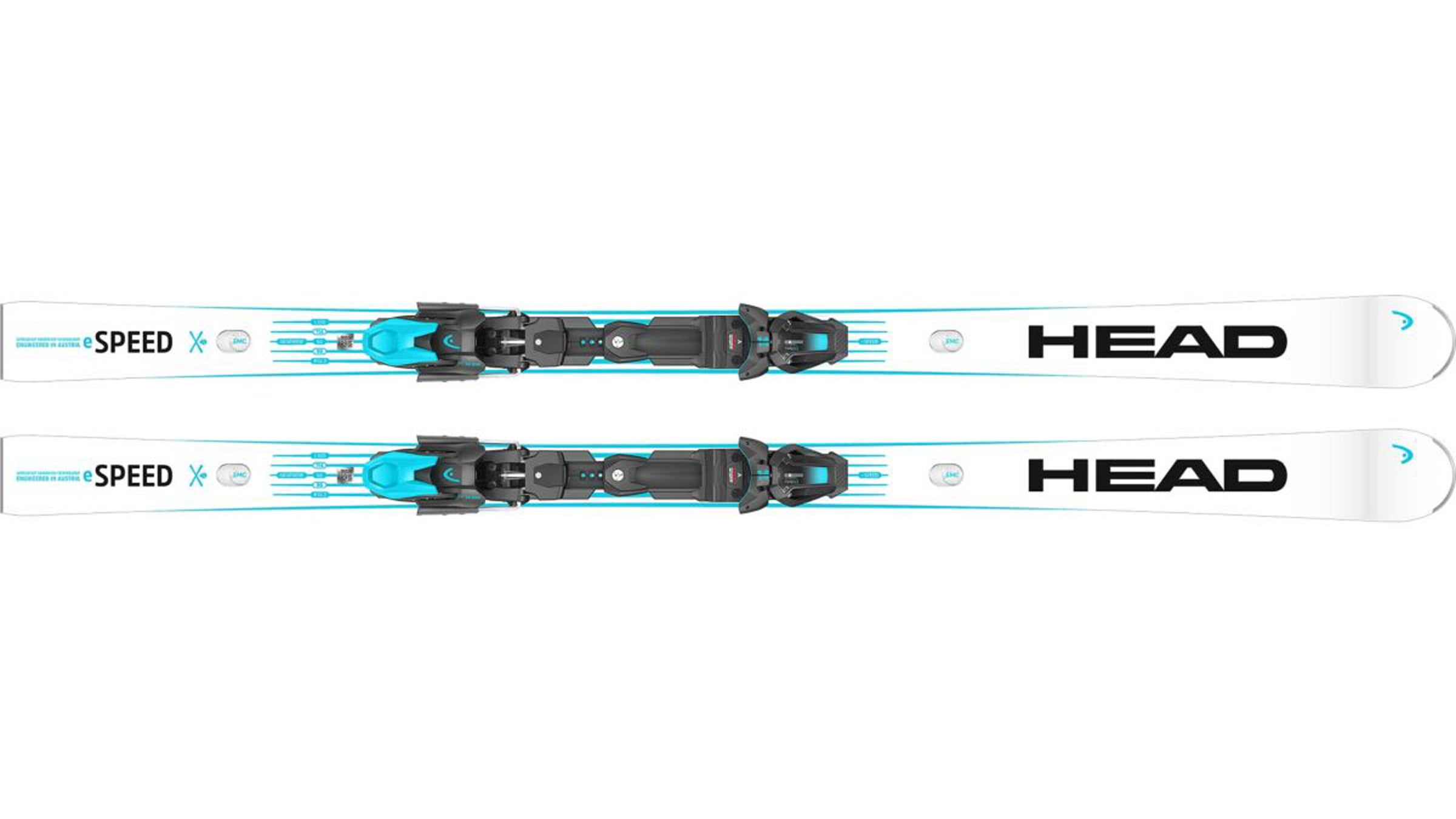
Best for Firm Snow: Head WC Rebels e-Speed
$1,338 with binding at Powder7
Lengths: 165, 170, 175, 180, 185 cm
Dimensions: 114-68-99 mm
Pros and Cons
⊕ Claw-like edge hold
⊕ Energetic
⊗ Heavy and taxing to ski
⊗ Tails are reluctant to release
For the second year in a row, testers were blown away by the Head e-Speed’s performance and ranked it No. 1 for hard-snow integrity and stability. “You can’t ask for a better tool for leaving your mark on firm snow and hard groomers,” said Luke Larsen, a Utah-based tester and shop owner. “You can feel the race DNA in this ski and it’s amazing.”
The e-Speed includes a race-inspired sandwich cap construction with Titanal and graphene, known for its high strength-to-weight ratio. But tweaks to the tip design eased turn initiation to make this ski more approachable. Also, Heads’s EMC (Energy Management Circuit) technology manages vibrations without losing rebound energy, adding smoothness and stability. “These skis are like rocket ships underfoot,” said Matt Coté, a five-foot-seven expert skier. “At my weight (145 pounds), they felt like a GS or super-G ski, and they need speed to come to life. But they’re stable, strong, and grippy without being hooky, with a race-like tail that digs in like a machete.”
A downside to the race-inspired construction: Testers felt it was taxing on the legs—getting the tails to release at the end of a turn before the ski was good and ready was a bit of a chore— and gave it low scores for forgiveness and playfulness as a result. But experts and aggressive skiers from coast to coast will be rewarded handsomely with rebound energy out of the turn and a slightly more approachable turn initiation than pure race skis afford.
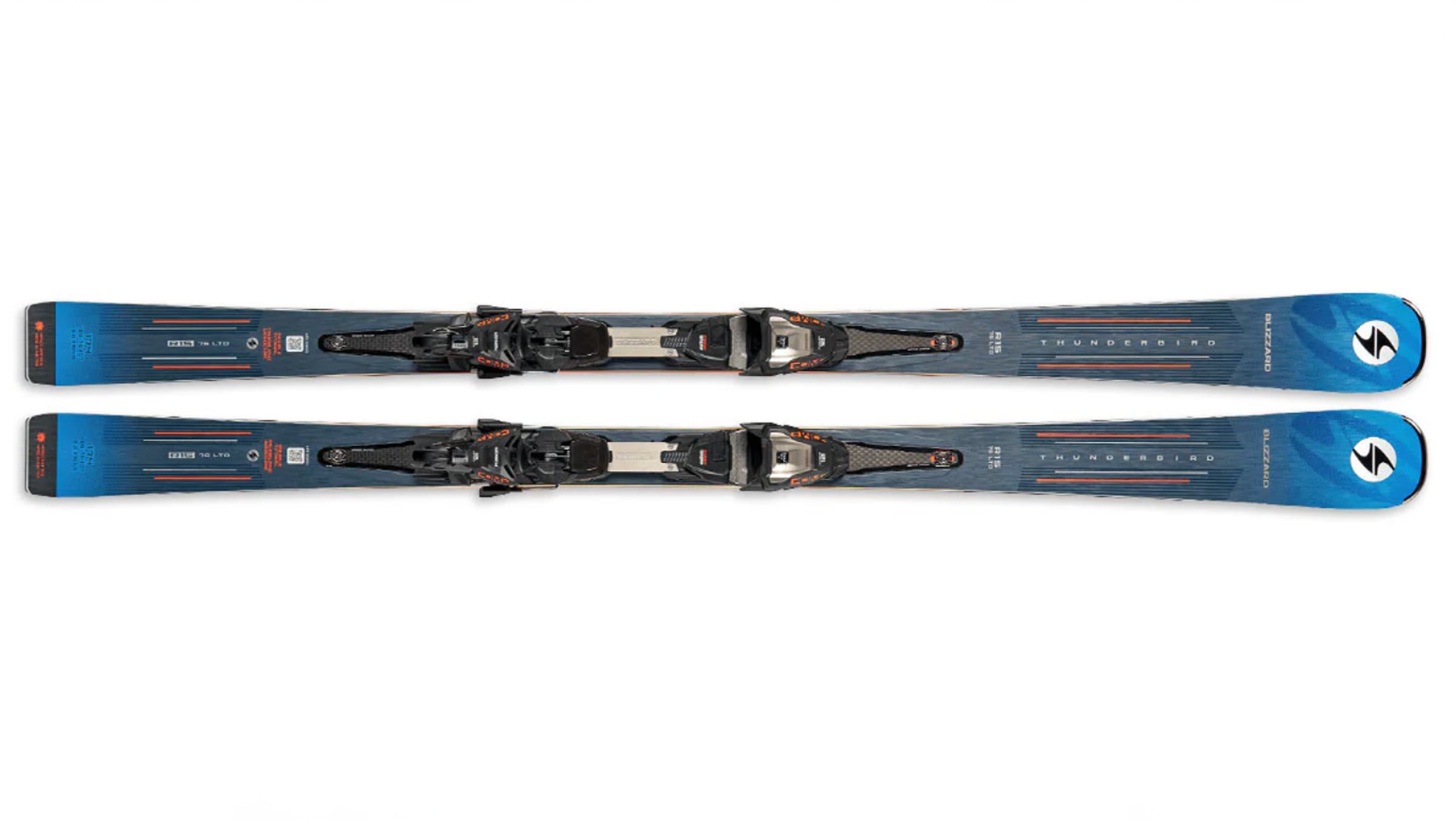
Most Fun: Blizzard Thunderbird R15 76 LTD
$1,300 with binding at Ski Town All-Stars
Lengths: 158, 166, 174, 182 cm
Dimensions: 126-76-107 mm
Pros and Cons
⊕ Fun and snappy
⊕ Confidence-inspiring
⊕ Approachable for intermediates and up
⊗ Fixated on medium radius turns
⊗ Loses stability in variable snow
If the Blizzard Thunderbird R15 76 was an exercise routine, it’d be dance cardio—more fun and seemingly less work and leg fatigue. Our test team put the 76-millimeter-waisted ski to work on the slopes of Big Sky, Montana, and they loved how the ski rewarded them with rebound energy out of the turn without punishing them if they made a mistake.
Like other top carvers on this list, Thunderbird R15 76 received high marks for hard-snow integrity and stability at speed; but testers wanted to create a new testing criterion for this model: the fun factor. “Sure, it’s easy to carve and schlarve, but mainly it’s just super fun and snappy, ” said RJ Peshek, a shop tech from Aspen, CO.
The fun/high performance combo that excited testers comes in part from Blizzard’s Trueblend Piste woodcore, which includes a soft flex zone in the tip and tail for easy turn initiation and release, with a hard flex zone in the center for edge grip and stability. Add in a carbon fiber plate and two layers of Titanal and presto—you get an energetic, snappy ski. “This ski is for the ripping intermediate to pro skiers who want to get out and spark arcs,” said Tommy Flitton, a 32-year-old ski coach.
Testers did caution that you can’t just chill on these skis—it takes energy to unlock the fun and a firm hand to guide it through variable snow. Also, with its slightly wider waist compared to other skis in the category, the Thunderbird’s turn shape favors medium radius turns and is reluctant to make shorter turns. But if you’re looking to add a strong and energetic carving ski to your quiver, this one will make you happy.
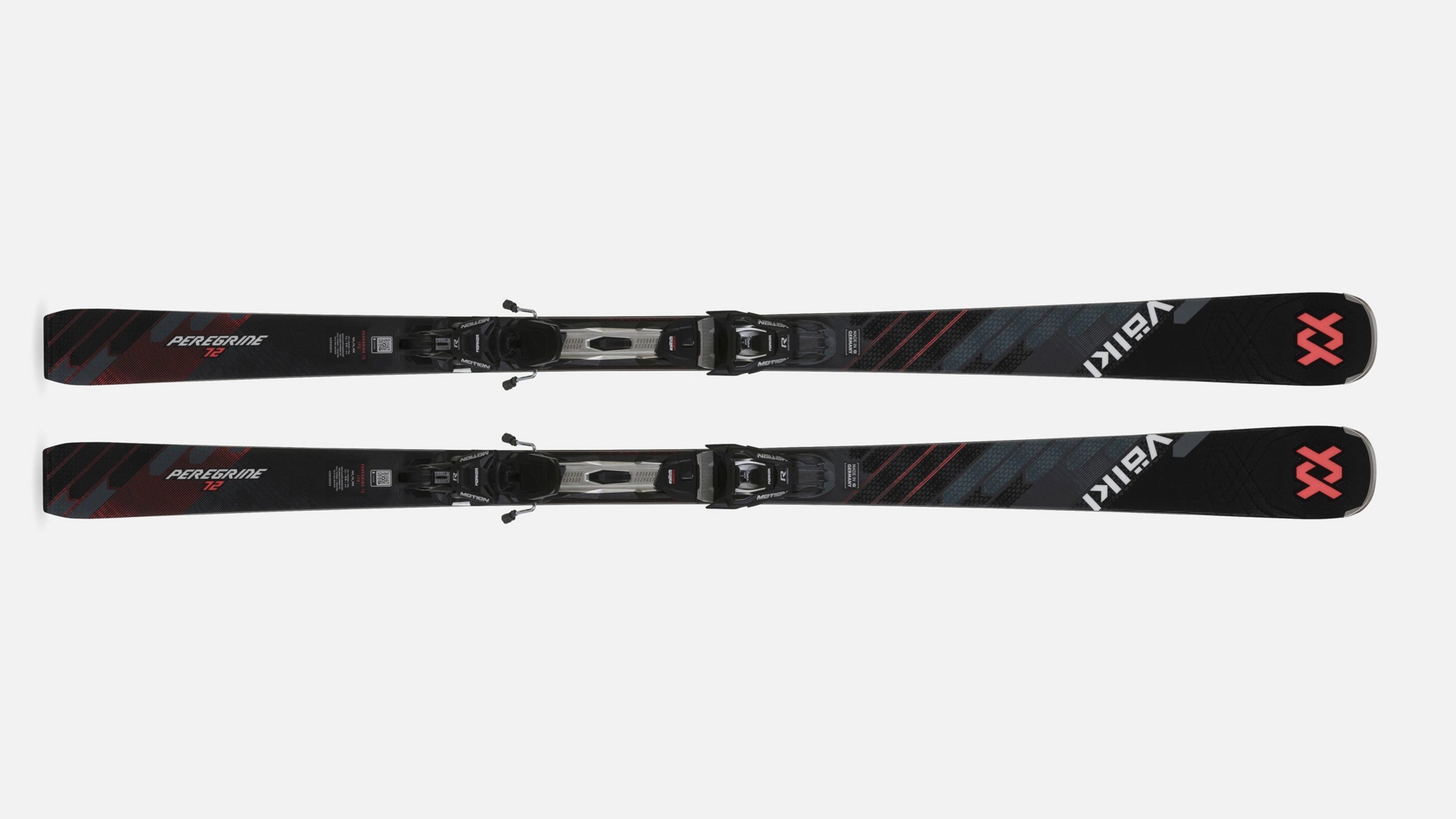
Most Responsive: Völkl Peregrine 72
Lengths: 158, 163, 168, 173, 178 cm
Dimensions: 122-72-103 mm
Pros and Cons
⊕ Stable tips
⊕ Quick and responsive edge-to-edge
⊗ Energy can overwhelm
⊗ Unforgiving of backseat driving
Like a falcon returning to the same mountain ledge, the Völkl Peregrine 72 once again lands in our tester’s top picks. The model gets a few key updates for 2026, most notably, a new binding/plate system that enhances power transfer. Though testers gave it low scores for forgiveness (it is named after a bird of prey after all), they awarded it the highest score for responsiveness among all the carving skis tested in Big Sky, Montana. “This ski predicts your turns before you even know it—the responsiveness of this ski is unmatched,” said Cooper Johnson, a Colorado-based tester. “It’s a spring-loaded canon when transitioning edge-to-edge.”
Testers recommend the Peregrine 72 for aggressive intermediates through expert skiers, particularly those who enjoy the feeling of rebound energy. Though energetic out of the turn, testers praised the ski’s stability that widens its accessibility. Völkl’s Tailored Carbon Tips, where carbon fiber stringers are strategically placed in the tips to control stiffness, add agility and ease of turn entry; the multi-wood core, with hardwood along the sidewall and softwood underfoot, enhances edge grip. The result, according to 33-year-old tester Alex Cernichiari, “is insanely stable tips that don’t even chatter over ice. This ski is a train on railroad tracks that rewards you with more than more you put into it.”
Fair warning: That same locomotive energy can also overwhelm less expert skiers. Though there’s softer wood underfoot, backseat drivers could get punished by the strong tail. But for skiers who prize stability, responsiveness, and strong edge hold, the Peregrine 76 is their bird of a feather.
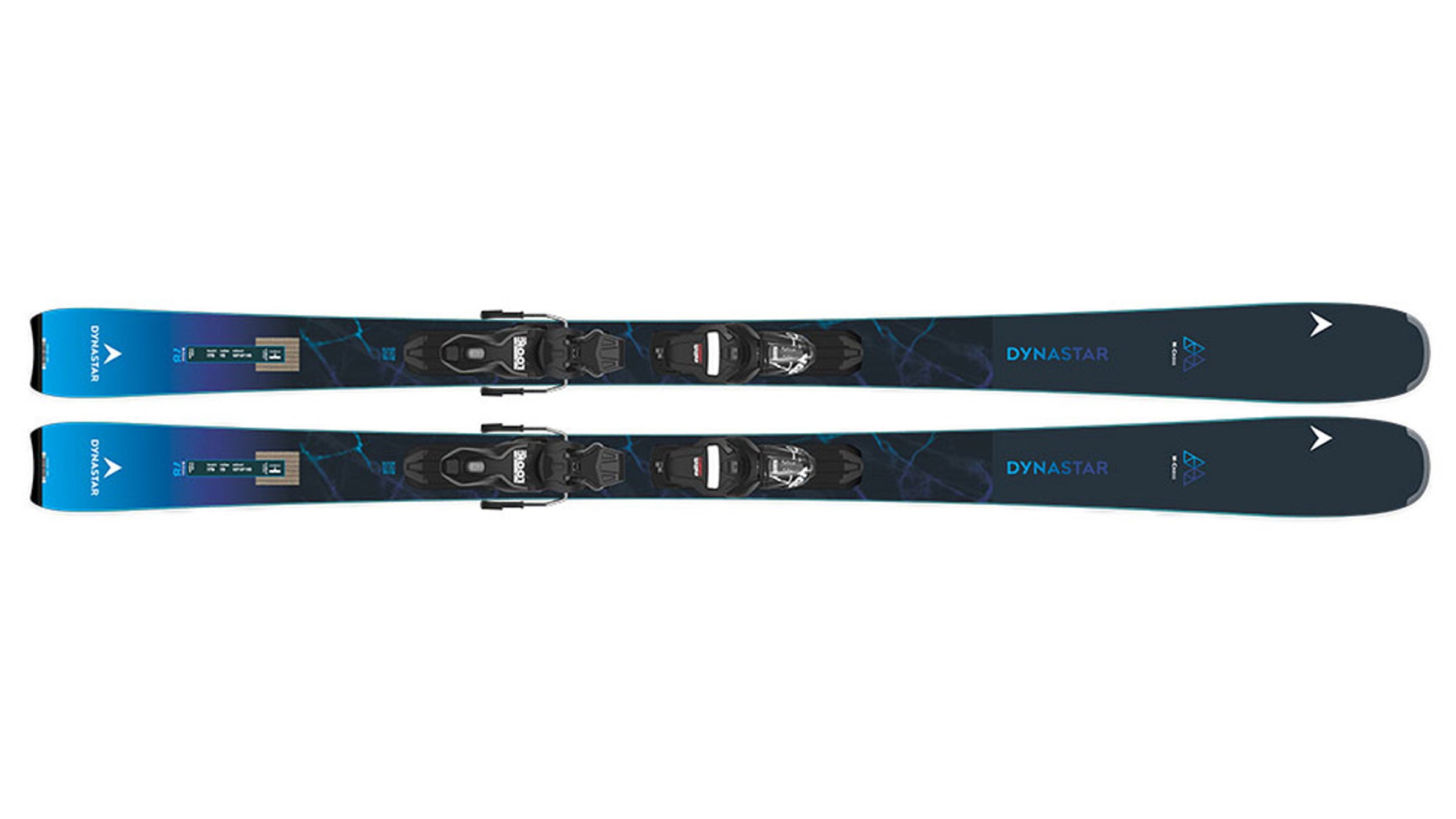
Best for Intermediates: Dynastar M-Cross 78
$550 with binding at Peter Glenn
$550 with binding at Suburban Ski & Bike
Lengths: 148, 156, 164, 172, 178 cm
Dimensions: 124-78-110 mm
Pros and Cons
⊕ Large sweet spot
⊕ Light and nimble
⊕ Very affordable
⊗ Easily overpowered by experts
⊗ Tips chatter at speed
If you’re new to skiing or just starting to carve turns on groomers, the Dynastar M-Cross 78 is a fantastic pick to help you progress without breaking the bank. At just $550 including bindings, this ski delivers exceptional value for beginners and intermediates who want a stable, forgiving ride as they grow their skills.
“The huge sweet spot and easy edge hold build confidence for developing skiers,” said Colorado-based tester Josh Lynch. “It performs at a variety of speeds and makes learning to carve fun.”
With Dynastar’s Hybrid Core 2.0 construction—a poplar wood core layered in three directions—the M-Cross 78 offers a smooth, predictable flex and a light, stable feel. A wide shovel with generous tip and tail rocker makes turn initiation effortless, while quick feedback underfoot makes it easy to pivot and control speed.
While this ski isn’t built for hard-charging experts or performance carving, it excels at what it’s designed to do: help newer skiers feel comfortable and confident on wide-open groomers. For anyone ready to take the next step in their skiing journey, the M-Cross 78 is a reliable, approachable, and budget-friendly tool to get you there
Section divider
More Skis We Recommend
The following carving skis are models that excel in specific areas like playfulness or forgiveness, offering strong alternatives for skiers with specific performance preferences.
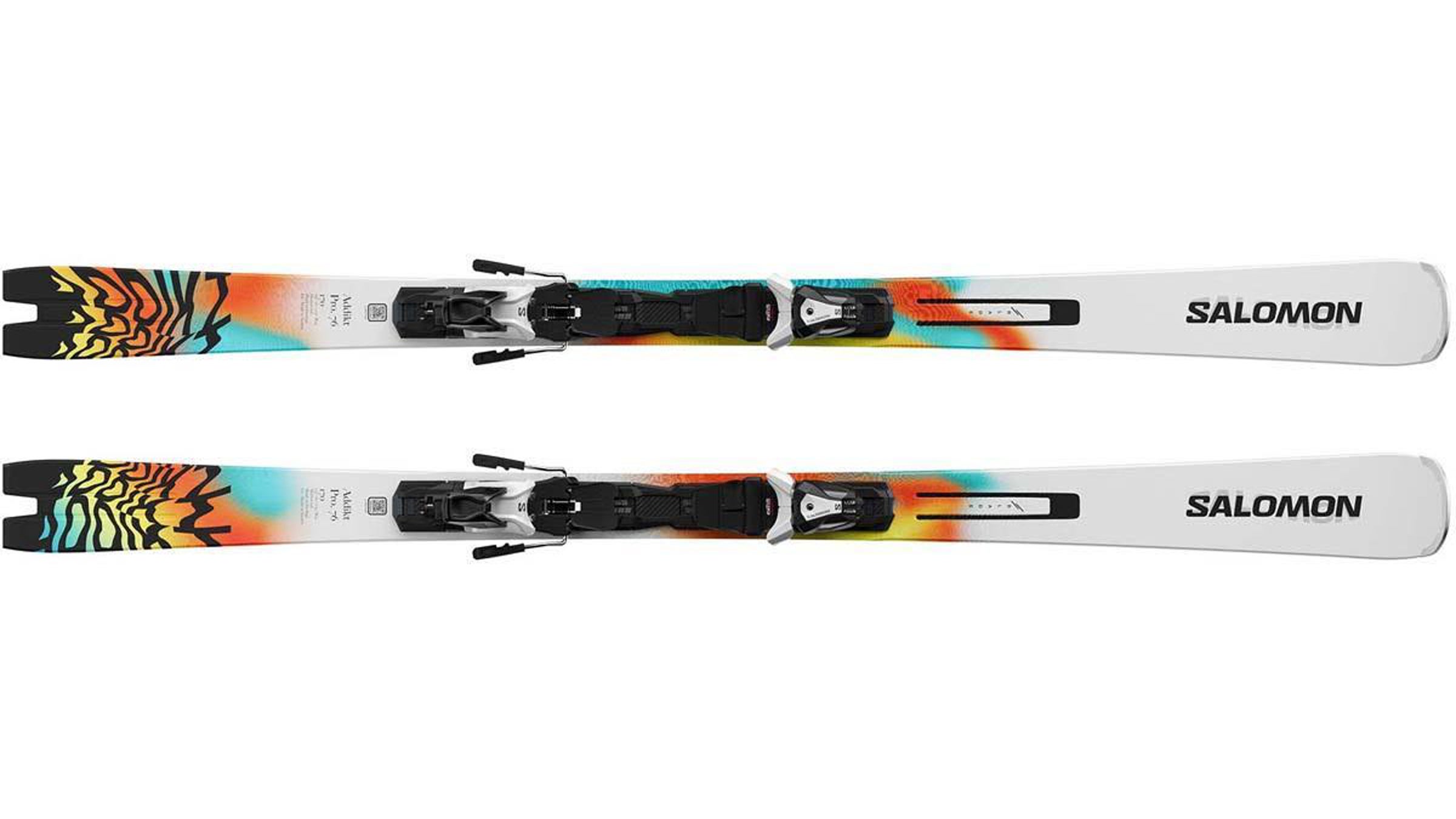
Salomon Addikt Pro 76
$1,000 with binding at Skis.com
$1,000 with binding at Salomon
Lengths: 156, 163, 170, 177 cm
Dimensions: 125-76-109 mm
Pros and Cons
⊕ Easy turn initiation and release
⊕ Slalom specialist
⊗ Tips chatter
⊗ Loses stability at speed
The French company Salomon has beaucoup de créativité. Case in point: the new Addikt Pro 76, featuring a new swallowtail design to make the tail more flexible and quicker to engage. Testers dug it: “This ski felt very unique compared to the rest of the skis we tested,” said Cooper Johnson, an Aspen-based ski technician. “It’s very snappy transitioning edge-to-edge and feels at once forgiving yet energetic.” While it wasn’t one of the top performers across the board, this 76-millimeter waisted ski earned the highest score in the category for quickness, as well as high marks for carving, prompting one tester and race coach to call it “a forgiving version of a slalom race ski.” The easy turn initiation and predictable energy release increases this carving ski’s accessibility for intermediates all the way to experts. Some testers noted that the Addikt Pro loses stability at speed, so don’t go full-send on this Salomon. But if you’re looking for a fun, energetic, and easy-to-ski carver with good edge hold, the Addikt Pro 76 is, according to one tester, “an absolute riot.”
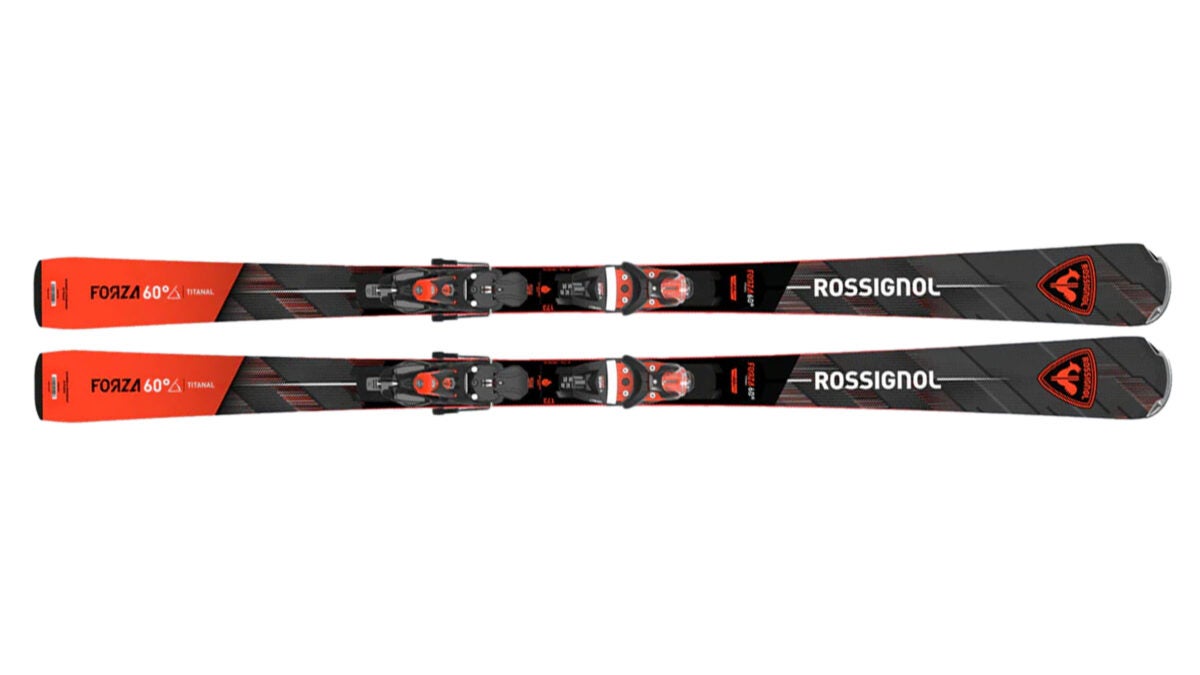
Rossignol Forza 60 Ti
$900 with binding at Ski Essentials
Lengths: 156, 164, 171, 179 cm
Dimensions: 130-75-112 mm
Pros and Cons
⊕ Large sweet spot
⊕ Energetic and fun
⊗ Can be overpowered
⊗ Has a speed limit
One tester joked that the Rossignol Forza 60 Ti would be best for East Coast racer dads. Sure enough, tester Chad Jacob—an actual East Coast racer dad—called this ski the most accessible ski in the test. In a category filled with hard-snow-obsessed models, the Forza 60 Ti received the highest scores for forgiveness. This doesn’t mean the ski lacks carving chops: its second-highest score was for carving, and the 13-meter radius means short swing turns come naturally for the 75-millimeter waisted ski. The Forza 60 Ti’s combo of easy turn initiation with power underfoot comes down to a blend of tip rocker, oversize dimensions, and a full sidewall construction. “It’s like golfing with an oversized club,” said Luke Larsen, a Utah-based ski shop owner. “This ski’s sweet spot is hard to miss.” Aggressive skiers should note that the Forza 60 Ti can be overpowered. “It can hinge if pushed too hard and it also has a speed limit,” said Larsen. But for groomer aficionados—dads or not—the Forza 60 Ti is an approachable ski with wide appeal.
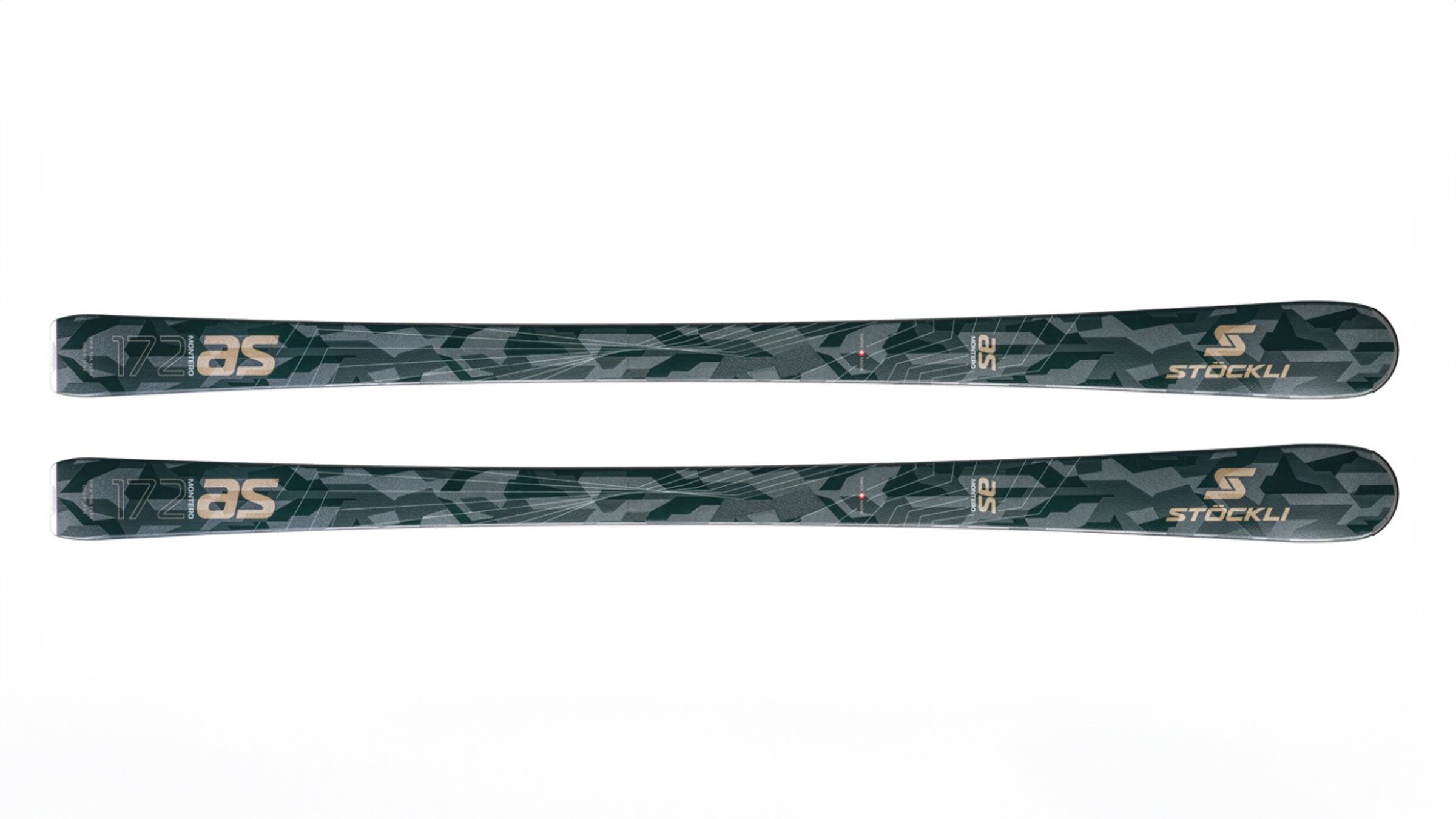
Stöckli Montero AS 76
Lengths: 160, 166, 172, 178 cm
Dimensions: 127-76-107 mm
Pros and Cons
⊕ Smooth
⊕ Precise carving performance
⊕ Tips chatter at speed
⊗ Punishes backseat drivers
⊗ Expensive
The newly-updated Montero AS 76 is the quintessential Stöckli ski: smooth and precise. “It’s the Rolls Royce of groomer skis,” said Tommy Flitton, a Utah-based tester. “It’s smooth as butter on the groomers, with easy turn initiation and great edge hold.” Stöckli’s Tip and Tail Flex technology—which uses S-shaped cuts in the Titanal of the tip and tail to soften the flex—further enhances the smooth release and easy turn initiation. But don’t mistake this ski for “soft;” it’s still on the stiffer, burlier end of the spectrum, and it will punish skiers who don’t actively drive it. As a result, testers recommend the 76-millimeter-waisted ski for technically sound skiers, with one tester noting: “It’s best for masters racers who won’t even look at a mogul.” Stöckli calls the model an all-mountain slalom ski, and testers loved making quick turns on firm snow. Just don’t expect a ton of rebound energy out of the turn—with the Montero AS 76, you’ll trade pizzazz for that signature Stöckli smoothness.
Section divider
Best Carving Skis Comparison
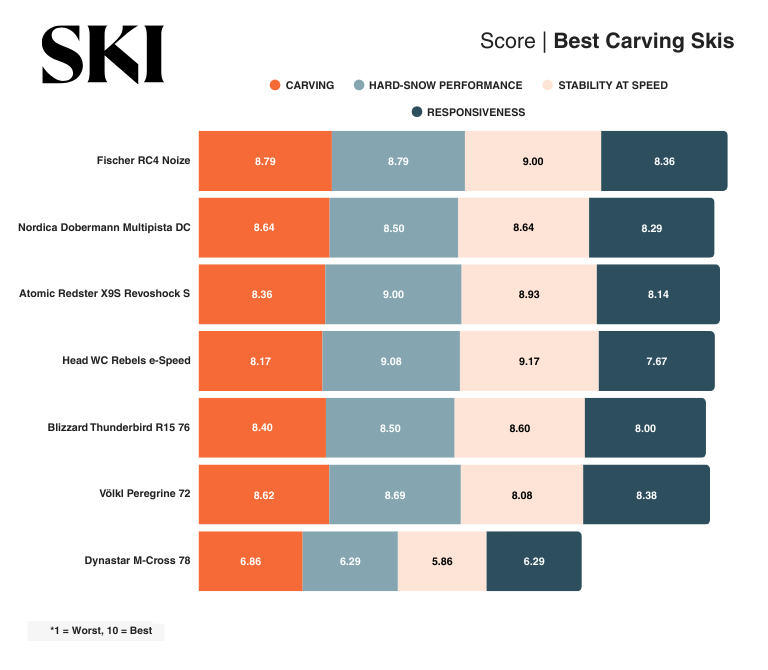
Section divider
How Does SKI Test and Review Skis?
[slideshow]184789,184781,184782,185019,185024,185025,185017[/slideshow]
About SKI Test
- Skis tested: 13
- Testers: 30 experts from the ski industry
- Location: Big Sky, Montana
- Tester range: Ages 21–57 | Heights: 5’4”–6’3” | Weights: 125–250 lbs
Each year, SKI’s editorial team conducts one of the most rigorous and trusted all-mountain ski tests in the industry. At the 2025 SKI Test in Big Sky, Montana, 30 experienced skiers from across the country tested 13 carving skis in real-world resort conditions. To reduce subjectivity, all testers skied each model on the same day, in the same conditions, and submitted digital scorecards evaluating each ski across nine criteria:
- Versatility
- Carving
- Hard-Snow Integrity
- Stability at Speed
- Responsiveness
- Crud Performance
- Quickness
- Forgiveness
- Playfulness
When judging the best carving skis, we place the greatest emphasis on hard-snow integrity, carving, and stability at speed—three key indicators of a top-tier carving ski. The seven winners on this list earned consistently high marks across all categories, especially those three. The skis included in the “More Skis We Recommend” section are models that excel in specific areas like playfulness or forgiveness, offering strong alternatives for skiers with specific performance preferences. Learn more about our testing methodology and scoring criteria here.
Why You Can Trust Us
Our ski reviews are the result of the largest, most rigorous on-snow test in the industry. We never charge brands to participate and don’t guarantee coverage—our annual SKI Test is a fully independent editorial project designed to deliver objective, in-depth reviews. Our expert testers include ski instructors, ski patrollers, ski shop owners, hardgoods buyers, ski technicians, and race and freeride coaches. We handpick this crew for their professional expertise and intentionally include a range of body types, ages, and home mountains to reflect the broader ski community. Bottom line: There’s no pay-to-play here—just honest feedback from people who know skis. Meet some of our veteran testers below:
Luke Larsen
Age: 43 | Height: 5’10” | Weight: 200 lbs
Larsen owns and operates The Lifthouse Ski Shop in Salt Lake City, Utah, with his brother Zac. He was born and raised in Utah’s Cottonwood Canyons, home of Snowbird, Alta, Brighton, and Solitude. When he was 4, Luke’s father would take him to work at the The Wood Haus Ski Shop at Brighton. He moved over to Snowbird when he was 6 years old to join the race team and continued to race until he was 19. Being a Snowbird boy, Larsen loves deep snow, but getting out on a pair of World Cup GS skis still puts a huge smile on his face.
Krista Crabtree
Age: 51 | Height: 5’8″ | Weight: 130 lbs
Crabtree spent every winter weekend brown-bagging lunch and skiing bell to bell in New Hampshire and ski racing around New England’s storied race hills. After a stint on the Bates College alpine ski team, she headed west to coach at Ski Club Vail, and then moved to the mountains above Boulder to get her Masters at the University of Colorado. An internship at SKI lead to eight years as an editor and director of the women’s ski test. She has been testing and writing about skis, boots, and gear since 1999.
Cooper Johnson
Age: 24 | Height: 6’ | a170
Johnson was born and bred in Aspen, Colorado, and cut his teeth on the slopes of Aspen Snowmass. He’s a ski technician at Hamilton Sports and founder of clothing brand Outpst. When he’s not tearing up the slopes around Aspen, you’ll find him at his sewing machine.
Section dividerFrequently Asked Questions
What is a carving ski?
Carving skis are the narrow-waisted skis designed for on-piste skiing only. Carving skis typically feature waist widths below 80 millimeters. With more exaggerated side cuts (hourglass shape) than you’ll find on wider skis, carving skis are designed to chew up corduroy and hardpack snow as well as make short radius slalom turns or long arcing GS turns.
Are carving skis only for experts?
It used to be that only the best skiers could handle the race-inspired skis available in the narrowest of waist widths. These stiff and demanding carving skis tended to be unapproachable to intermediates and advanced skiers looking to improve their technique. But that’s no longer the case. Featuring more tip rocker, wider shovels, and lighterweight construction materials than carving skis of the past, many models now allow strong intermediates to experience the locked-in feeling and power of these narrow-waisted skis.
What’s the best carving ski for experts?
Our top carving ski for experts in 2026 is the Fischer RC4 Noize. It outperformed all the other carving skis we tested in Big Sky, Montana. Testers raved about its carving ability on groomed terrain, its precision on edge, and its smooth feeling underfoot. Read more here.
What’s the best carving ski for women?
For 2026, our testers named the Head WC Rebels e-Race the best carving ski for women. Technically a unisex ski, our female testers appreciated its precision, dependability, and carving abilities. Read more about the Head WC Rebels e-Race here.
What’s the difference between a carving ski and a frontside ski?
Carving skis give it away in the name: they’re built to arc carved turns on groomed terrain. Think race skis, but made more accessible to the everyday skier. Frontside skis can be just as reliable on groomers and hardpack, even with a little added tip rocker. But because frontside skis are typically a little straighter from tip to tail with a slightly wider waist, they don’t have the same innate carving capabilities as carving skis. Where frontside skis win out is in the versatility department—they’re designed to perform even off the groomers.
In short: Carving skis are the scalpels of skis, designed to be handled by an experienced hand and leave precise incisions on the snow. A frontside ski is more like a machete—it’s still sharp and effective but doesn’t require you to be as precise in your cutting.
What’s the difference between men’s and women’s skis?
In truth, most skis are unisex and not gender-specific. Many brands produce the ski with the exact same construction technologies for both genders, but often create two different top sheets/graphics to appeal to men vs. women. In general, men and women can use the same ski but may want to choose different lengths depending on their height, weight, and their skiing style/ability. A handful of brands design true women’s skis with construction tweaks for female physiology. These skis generally come in shorter lengths (from 170 cm down to 150 cm) and use slightly softer, lighter construction materials.
What size ski is right for me?
As a general rule of thumb, the shorter the ski, the easier it is to turn and control. So if you’re a beginner, reach for a ski that’s about chin-height. More advanced skiers often choose skis that are as long as they are tall, since longer skis provide more stability at speed and float in deep snow. So the best ski length for you will depend on your height, your skill level, and what type of skiing you hope to do. A ski-shop employee can help point you in the right direction.
Note that ski length is relative. Narrow carving skis tend to ski longer than their length because they feature more effective edge, while powder skis tend to ski shorter than their length because they feature more rocker in the tip and tail. Learn more here.
More from the 2026 Winter Gear Guide
The Best Women’s Carving Skis
The Best All-Mountain Skis
The Best Frontside Skis
